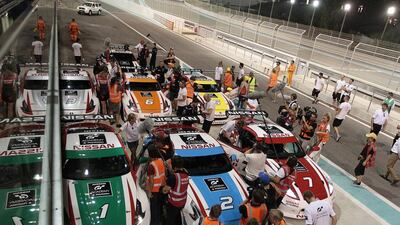Tyres squeal, engines rev, a chequered flag waves and the smell of burning rubber fills the air.
Anyone strolling into the Yas Marina Circuit grandstand would be forgiven for thinking they are watching a professional race meet. In reality, the drivers on the track were behind the wheel of a racing car solo for the very first time.
I'm on the set of GT Academy, a reality-TV series that gives accomplished fans of racing video games a chance to get behind the wheel for real, and compete for a real-life motorsport career. Ten days of filming in Abu Dhabi wrapped with a frantic final race last week.
The visit to the capital marked the first time the hit show – watched last year by 78 million fans in 120 countries – has hosted a “race camp” outside of the United Kingdom.
Camp Abu Dhabi
More than 200 cast and crew members were put up on Yas Island – in the Yas Viceroy, Radisson Blu and Yas Island Rotana hotels. They included 56 competitors and seven film crews, one for each version of the show made in different languages. Fourteen Nissan 370Z racing cars were shipped over, with the winning contestant invited to race for the brand professionally.
All of the previous seasons of the contest have been hosted at the United Kingdom’s Silverstone Circuit. Team leader Miguel Faisca said the hotter climate in Abu Dhabi offered fresh technical challenges.
“It’s a very different experience,” said the Portuguese coach. “Everything is usually at 20°C – here it’s 40°C. It’s very hard for the cars, as well as the drivers.”
Thousands of PlayStation gamers apply every year to compete on the show by clocking the fastest laptimes on the video game Gran Turismo. This time, 56 contestants from 11 countries were selected to travel to Abu Dhabi for this European edition of the contest. This pack was whittled down to seven who lined up on the starting grid for Monday's final showdown.
While the racers had hit the track earlier in the week for a series of challenges, including drifting, drag racing and carting, this was the first time the finalists had driven on the track without an instructor.
The qualifying round, to decide pole position, was conducted “virtually” on a Sony PlayStation a night earlier in Rush bar.
In the end, French contestant Romain Sarazin comfortably outstripped the competition and will go on to join Nissan’s Driver Development Programme.
Does it really work?
The big question is, of course, whether you can really find the next Lewis Hamilton by weeding through a bunch of geeky gamers. Does skill with a joypad translate to ability behind a real steering wheel?
The evidence suggests it does. The winner of inaugural GT Academy, in 2008, Lucas Ordóñez, might be the best success story – he finished second in the LM P2 category at Le Mans three years later, and third in 2013.
“If you’d asked me three years ago, I would have probably laughed,” says British motorsport legend Adrian Newey from the pit lane. He is the chief technical officer of Red Bull Racing Formula One.
“But keeping an eye on it, I think it’s a growing alternative route in. At Red Bull, we’re starting to see the drivers who are best in simulators are best in the car – there’s clearly a correlation between the virtual environment and real world.
“It’s a different way of gaining experience. Who is to say that gaming is less relevant than driving a cart, which is the conventional way into motorsports? A cart is not a car.”
Last year’s winner, Gaëtan Paletou, graduated to cometet in his first Le Mans in June.
"GT Academy is the future," says the 23-year-old Frenchman. "It's completely changed my life is so many ways – I'm living the dream."
Visit Abu Dhabi
As well as getting behind the wheel, contestants faced a variety of fitness challenges across the emirates. These included riding dune buggies, a gruelling adventure course at Yas Waterworld, and camping Bedouin-style in the desert – while the crew were put up in luxury at the nearby Qasr Al Sarab Desert Resort by Anantara.
“It’s been an incredibly challenging week,” says Belgium finalist Emile De Dryver from the starting grid, “but it feels good”.
Contestants who didn’t make the final rounds were taken on trips to attractions including Ferrari World, while Newey was spotted enjoying a spot of downtime on the greens at Yas Links Abu Dhabi golf course.
A key intro scene captured a helicopter delivering the judging panel to Nation Towers.
All of the UAE footage will be condensed into four 25-minute episodes, due to be broadcast next year.
The whole thing, of course, makes for great publicity for Abu Dhabi. The production benefited from the 30 per cent cash rebate from the Abu Dhabi Film Commission, designed to attract film and TV crews to the emirate, while twofour54 provided on-the-ground support and production services. Both groups are part of Abu Dhabi Media Zone Authority.
“Here, you have a very glamorous location, and one of the best Formula One circuits in the world,” says Daniel Whittemore, account director for GTA Global.
Paletou adds that Abu Dhabi offered competitors distractions he didn’t encounter last year. “In Silverstone, it’s a real boot camp – waking up early, cold, bad British food,” says the 2014 winner.
“Here it was harder to concentrate. We had great food, amazing hotels – it’s been like a holiday.”
rgaratt@thenational.ae

